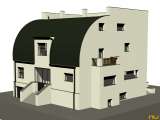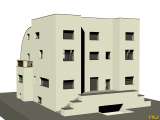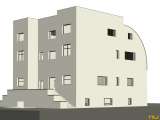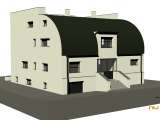
|
interpretative model

|

|

|

|

|
plans
|
|
Villa Steiner, plans |
analysis
|
In 1909 Hugh Steiner contracts Adolf Loos to design his house, located in a small parcel of the Hietzing neighbourhood in Vienna. Within a ground plan of 10 x 10 m (32.8 x 32.8 ft), the house is divided in four levels (including a basement) that distribute space according to function, revealing Loos interest towards different levels of privacy within the domestic living space. Thus, the ground floor contains the vast âcomfortableâ space of the living room connected to the garden, as well as the dinning room, the music room and the library, all considered primary vital functions. Loos wraps these spaces with an oak wooden covering, the same material is used for the roof beams, which alternate with white plastered surfaces and face-work, an absolute novelty in 1900âs Viennaâthe Wiener Werkstäte of Hoffmannâs Viennaâthat reminds us architect Richardson and his Glessner House (1887). The image is complete with the carefully made rustic design of the furniture that become joint to the walls through horizontal strips, arranging the continuum of interior composition whilst the roomâs center is emptied progressively in a sort of centrifugal movement of the ground floor. Loos locates dormitories and studios in the first floor, distributing in the other two levels (basement and second floor) auxiliary and service functions (kitchen, sewing room, servantsâ area, and pantry). The load-bearing walls structure of the house distributes different spaces in the interior, as well as other functional elements such as stairs or service equipment. Circulations within the house directly communicate one space to the nextâan aspect also found in other Loosâ houses, as a chain of spaces in a perfectly defined perimeter, without gradual anticipation or flow, as we would find in any work designed by Wright at that moment. The path from the main door to the living room is not crossed with the same axis-like direction found in the facades, but with a turn to the hallâs direction and a few steps placed in the right side. The window openings are placed empirically according to their functions within the interior Raumplan and their relations with the exterior. They display certain syntax close to those Anglo-Saxon tradition models praised in his writings. The white wall covering (âlike antique Viennese housesâ), austere and not ornamented, as well as the curved zinc-sheeted roof that characterize this house reveal one of the most important aspects of Loosâ abstraction: the analytic vision of history expressed in traditional techniques updating. Following the guidelines written in his contemporary essay Architecture, it is easy to see that the building expresses the division between public and private, manifested in a positive interior, rich and individual, opposed to a negative exterior, silent, urban. Furthermore, Steiner House project coincides in time with the American Bar (1907), the Michaelerplatz (1909) and with the writings Ornament and Crime (1908) and Architecture (1909), a time when Loos lived a moment of great intensity and coherence. (F.A.P.) |
related works
|
Rufer House
Tristan Tzara House Villa MĂźller |
bibliography
|
plans and models made by: 2006 - Ruth Rodericks Giralt |
|
TOURNIKJOTIS, Panayotis. Adolf Loos. ParĂs: Ed. Macula, 1991. LOOS, Adolf. Escritos I y II (al cuidado de Adolf Opel y Josep Quetglas). Madrid: El Croquis Editorial, 1993. TREVISOL, Robert. Adolf Loos. Roma: Ed. Laterza, 1995. O DANTI, Giovanni y PERIONE, Silvia. Adolf Loos: la cultura del progetto. Roma: Officina Edizione, 1995. GRAVAGNUOLO, Benedetto. Adolf Loos: Teoria y obras. Madrid: Editorial Nerea, 1998. SCHEZEN, Roberto. Adolf Loos: Architecture 1903-1932. Nueva York: The Monacelli Press, 1996. |
comments/essays






